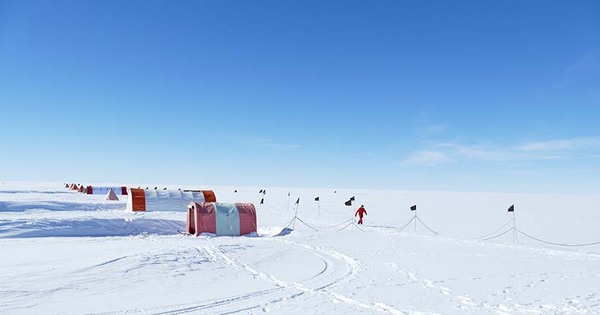Researchers discovered the first concrete evidence that the West Antarctic Ice Sheet shrank abruptly and dramatically toward the end of the Last Ice Age, some eight thousand years ago. The evidence, preserved within an ice core, demonstrates that in one spot, the ice sheet thinned by 450 meters — more than the height of the Empire State Building — in little under 200 years.
Researchers from the University of Cambridge and the British Antarctic Survey have discovered the first direct evidence that the West Antarctic Ice Sheet shrank abruptly and dramatically toward the end of the Last Ice Age, approximately 8,000 years ago.
The evidence, preserved within an ice core, demonstrates that in one spot, the ice sheet thinned by 450 meters — more than the height of the Empire State Building — in little under 200 years.
This is the first evidence of rapid ice loss in Antarctica. Scientists are concerned that rising temperatures now will destabilize areas of the West Antarctic Ice Sheet in the future, potentially reaching a tipping point and causing a rapid collapse. The new study, published in Nature Geoscience, provides insight into how quickly Antarctic ice could melt if temperatures continue to rise.
We wanted to know what happened to the West Antarctic Ice Sheet at the end of the Last Ice Age, when temperatures on Earth were rising, albeit at a slower rate than current anthropogenic warming. Using ice cores we can go back to that time and estimate the ice sheet’s thickness and extent.
Dr Isobel Rowell
“We now have direct evidence that this ice sheet suffered rapid ice loss in the past,” said Professor Eric Wolff, senior author of the new study from Cambridge’s Department of Earth Sciences. “This scenario isn’t something that exists only in our model predictions and it could happen again if parts of this ice sheet becomes unstable.”
The Antarctic ice sheets, from west to east, contain enough fresh water to raise global sea levels by around 57 meters. The West Antarctic Ice Sheet is considered particularly vulnerable because much of it sits on bedrock that lies below sea level.
According to model forecasts, a major portion of the West Antarctic Ice Sheet may melt during the next few millennia, causing sea levels to increase. However, it is unclear when and how rapidly the ice will melt.
One method for training ice sheet models to produce better predictions is to feed them data on ice loss during episodes of warming in Earth’s history. At the peak of the Last Ice Age 20,000 years ago, Antarctic ice covered a larger area than it does today. As our planet thawed and temperatures gradually rose, the West Antarctic Ice Sheet shrank to around its current size.

“We wanted to know what happened to the West Antarctic Ice Sheet at the end of the Last Ice Age, when temperatures on Earth were rising, albeit at a slower rate than current anthropogenic warming,” said Dr Isobel Rowell, study co-author from the British Antarctic Survey. “Using ice cores we can go back to that time and estimate the ice sheet’s thickness and extent.”
Ice cores are composed of layers of ice produced as snow fell, which were subsequently buried and compacted into ice crystals over thousands of years. Bubbles of old air and impurities combined with each year’s snowfall are trapped within each ice layer, revealing information about the changing climate and ice extent.
In 2019, the team excavated a 651-metre ice core from the Skytrain Ice Rise. This ice mound is located at the ice sheet’s border, close to where grounded ice flows into the floating Ronne Ice Shelf.
After transporting the ice cores back to Cambridge at -20oC, the researchers analyzed them to reconstruct the ice thickness. First, they measured stable water isotopes, which indicate the temperature at the time the snow fell. Temperature decreases at higher altitudes (think of cold mountain air), so they were able to equate warmer temperatures with lower-lying, thinner ice.
They also measured the pressure of air bubbles trapped in the ice. Like temperature, air pressure also varies systematically with elevation. Lower-lying, thinner ice contains higher-pressure air bubbles. These measurements told them that ice thinned rapidly 8,000 years ago. “Once the ice thinned, it shrunk really fast,” said Wolff, “this was clearly a tipping point — a runaway process.”
They believe this thinning was caused by warm water seeping beneath the edge of the West Antarctic Ice Sheet, which is normally resting on bedrock. This most likely freed a part of the ice from bedrock, allowing it to drift out and form what is now the Ronne Ice Shelf. This allowed the nearby Skytrain Ice Rise, which was no longer constrained by grounded ice, to thin quickly.
The researchers also discovered that the sodium content of the ice (derived from salt in sea spray) increased approximately 300 years after the ice thinned. This warned them that as the ice thinned, the ice shelf receded, bringing the sea hundreds of km closer to their location.
“We already knew from models that the ice thinned at around this time, but the date of this was uncertain,” Rowell added. Ice sheet models estimated that the retreat occurred between 12,000 and 5,000 years ago, but they could not predict how quickly. “We now have a very precisely dated observation of that retreat which can be built into improved models,” Rowell went on to say.
Although the West Antarctic Ice Sheet receded rapidly 8,000 years ago, it stabilized when it reached roughly its current size. “It’s now crucial to find out whether extra warmth could destabilize the ice and cause it to start retreating again,” Wolff added.
















